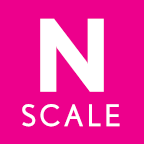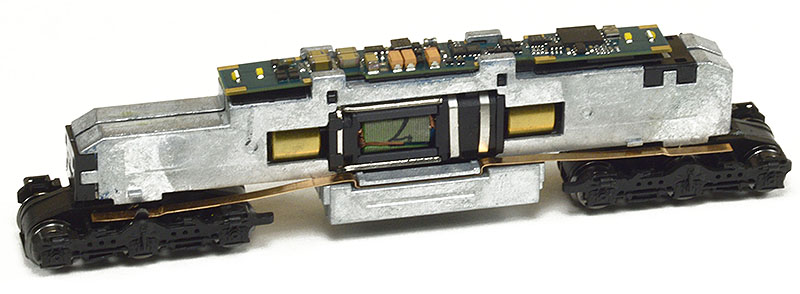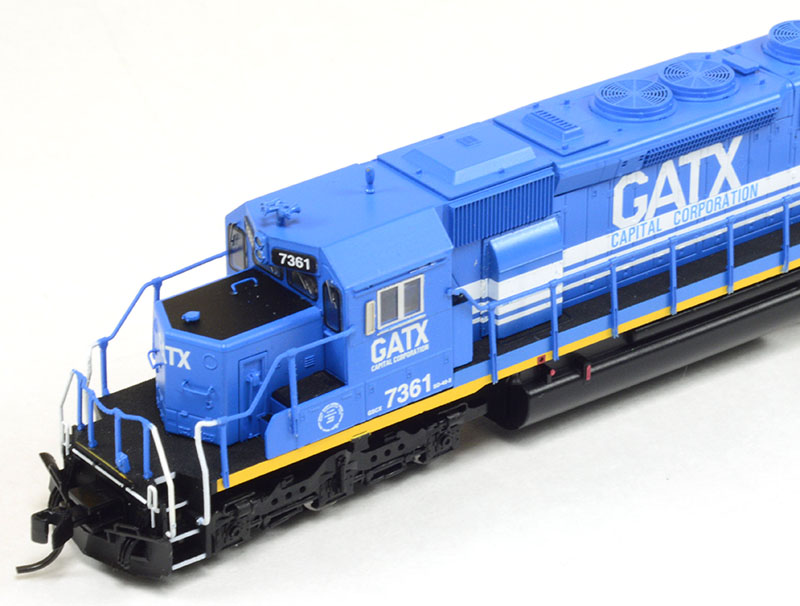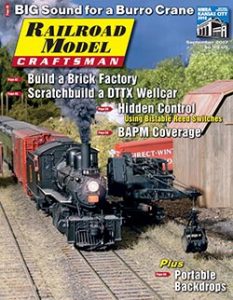 Review by Shane Mason/Photos by the author
Review by Shane Mason/Photos by the author
Electro-Motive Division built 3,949 SD40-2s beginning in 1972 with production ending in 1986. The “Dash 2” line was a complete redesign of the SD40, introduced in 1966, including close to 40 different component changes to improve performance and ease of maintenance on the locomotives. Build differences included new HT-C trucks, improved wheel-slip controls, multiple prime mover upgrades, as well as improvements to the traction motors and alternator. The Dash 2s also brought a brand-new electrical system on board that made the numerous switches, contacts, and relays of the first-generation locomotives a thing of the past. One of the most noticeable changes between the SD40 and SD40-2s was the added three feet to the overall body length to make room under the frame for the longer HT-C trucks. This space was added by extending the tail end walkway creating the famously named “back porch.”
The first EMD SD40-2 to roll out of the shops at La Grange, Illinois, was Kansas City Southern 637 in January 1972. Although the Dash 2s didn’t seem very different from SD40 predecessors, they outperformed the 40s with reliability rates increasing from 10 to 15 percent along with a significant increase in tractive effort.
Regular production ended in February 1986 with the completion of an NdeM (13001–13004) order. A short time after, Canadian Pacific talked the diesel builder into one last order of 25 SD40-2s. These last 25, labeled SD40-2Fs, and making up Canadian Pacific’s 9000–9024 series, became the final locomotives produced in the SD40 collection on completion in November 1988.
In the end, the SD40 became the most successful locomotive ever for EMD, selling more than 5,000 units with the SD40-2s being the most popular of the bunch. Even now, some 45 years later, the SD40–2 still shows its worth today. The SD40–2 can still be found in many yard and short lines across North America hauling freight with original EMD 645E3 diesel engines. Railfans have come to love this diesel.

On the Surface
Both InterMountain Railway Co. N-scale SD40–2 models look great at first glance. The paint is crisp and clean. The lettering and heralds appear to be straight and square on the model as well. The overall paint schemes on both models match prototype photos very well. Nice touches that are often overlooked are white- or yellow-painted handrails, step faces, and coupler cut levers. Railroad Model Craftsman’s Iowa, Chicago & Eastern (IC&E) SD40–2 model sample also has a painted brake wheel.
After a closer look, there are a handful of flaws compared to the prototype, such as a few missing or misplaced warning placards. The two biggest misses I noticed appear on the Iowa, Chicago & Eastern unit. The prototype has a large builder’s plate on the fireman’s side just before the cab on the sill, as well as an antenna over the engineer-side number board.
These very well-equipped models feature both molded-in details and a number of separately applied details, including antennas, horns, fan grilles, coupler cut levers, MU hoses, windshield wipers, wind deflectors, cab shades, and grab irons on the nose and tail of the locomotive body. As with all InterMountain locomotives I’ve experienced, the sun shades are inside a small bag in the box. The shell has two pre-drilled holes above the side windows for the two fingers on the shades to insert into the cab. The only issue I had with the brass parts was the middle radiator fan screen popping off, which is not the end of the world — a dot of CA glue had the part back in place in no time.
The fuel tank is molded plastic with painted red cap and fuel level gauge on each side of the tanks. The model also has air tanks above the fuel tank but are not highly detailed. The light blue GATX SD40–2 sports a ratchet handbrake, while the IC&E model includes an accurate brake wheel on the nose. InterMountain has taken the time to paint the handbrake wheel to match the rest of the paint rather than using colored plastic that can lead to a color that is not the same shade or gives the detail a slightly clear or translucent look.
Visually, two spaces stand out on these locomotive models. The abundance of space between the walkway and the truck makes them look like they ride a bit tall. On the prototype, this space is much narrower. The trucks also have a visual gap on the ends closest to the fuel tank. The space between the truck frames is normally taken up by traction motor; however, on the model, it seems to have been cut away. Both gaps are not a deal breaker and can be fixed with some styrene and paint but still create a visual “catch” when looking over the models. Both IC&E and GATX examples had wheels that were in check with NMRA Standards. All couplers also check out against the Micro-Trains height gauge.

DCC and Sound
InterMountain has introduced a new style of N-scale drop-in board that will now streamline the process of adding Digital Command Control (DCC) or DCC/sound to a locomotive. The new boards are part of a new “slide-in” line and come in both DCC and DCC/sound for InterMountain locomotive releases. The ESU LokPilot (#54650) is the DCC motor decoder. The LokPilot decoders from ESU are simple DCC (non-sound) decoders that run the same as the Lok- Sound decoders for seamless performance between the two models. The ESU LokPilot is designed to fit InterMountain locomotives from the SD40–2s and on to newer releases, which allows for upgrading of your InterMountain locomotives with ESU sound decoders. ESU’s LokSound Direct (#73100) is designed to fit into InterMountain’s locomotives built before its new SD40-2, such as the SD40T-2 and others. It will install the same as other DCC brands do into the frame, ensuring that your past models will run seamlessly with newer models that will be coming out in the future, while also adding sound to your existing fleet. ESU is also releasing a new Lok- Sound board for locomotives that will be produced in the future; the LokSound Select (#73199) board will be a universal fit for InterMountain locomotives starting with the new N-scale SD40-2s.
Our GATX 7361 sample is equipped with the LokPilot (non-sound) decoder while the IC&E #6418 has a LokSound Select. Both of RMC’s models exhibit excellent motor control and very nice lighting effects. One problem that did stand out was that the lights were very dim. I found after removing the shell and holding an LED to the ends of the light tubes inside the shell, it seems like the LEDs on the decoder board may be too far from the light tubing, causing the tubes to not pick up enough light. The LokPilot and LokSound decoder both run very well together. After some slight adjustments, both units matched in speed and momentum with some push/pull between the two but, once added to a string of cars, should be eliminated with the added weight.
The IC&E 6418 sounds just as good as it looks with ESU LokSound and an increasingly popular cell phone speaker with its baffle mounted in the fuel tank. This is a notable feature; the newer cellphone style speakers have a much better range and sound quality in comparison to the circle speakers normally seen in N scale locomotives with factory-equipped sound. The EMD 645E3 recording is crisp and smooth in transition from notch to notch. The sounds on the decoder include the prime mover, four different bells, 16 different air horns, spitters, compressor, dynamic-and-radiator fans, coupler crash, and more. It is also very easy to upgrade a locomotive to the new ESU LokSound “Full Throttle” files.

Simply by using the ESU LokProgrammer and software, you can upload a new file to the decoder in about 20 minutes. You can pick from five different available EMD 654E3 files, giving your locomotives different prime mover sounds so that each SD40–2 doesn’t sound like the unit next to it. Although the sound decoder will work in DC mode, DCC is the way to get the most out of these locomotives.
The new “Full Throttle” features from ESU are a nice addition to the models, bringing even more realism to your locomotives. “Full Throttle” allows you to set the locomotive to a speed step, and then adjust the prime mover sounds for grades or to coast for switching. It is all up to the user as to what the locomotive does, which is different from other decoders in the sense that ESU’s decoder automatically makes the notch/load adjustments for you. ESU also has button features with the “Full Throttle” that allows for coasting and a “Notch 8” button for those long hills. This function puts the engine in idle or Notch 8, while still allowing you to adjust the speed steps. The coast mode also works well for nondynamic- brake-equipped locomotives by setting the coast button to the same button as the dynamic brakes for the rest of the consist. Whichever units are not sporting dynamics will roll along in idle, while the rest of the power brakes against the grade.
Programming for both the LokSound and LokPilot decoders can be done through either your normal process of CV (Configuration Variable) programming or through the ESU LokProgrammer. A volume CV chart is provided with the model in the box, but a more extensive guide can be found on ESU’s website under the “Downloads” tab.
The new InterMountain Railway Co. N-scale SD40-2 diesel is a good looking model. InterMountain has taken the time to try to get details on these models right. The most exciting feature for the tech guys would be the easy-to-upgrade DCC/Sound and the complete redesign of the frame, as well as the improved hardware under the hood. ESU also brings more to the table with superior running and “Full Throttle” effects. Whether these SD40–2s are leading trains in the 1970s on your main line or building trains in yards the 2000s, these locomotives are sure to earn their keep on any N-scale layout.
InterMountain Railway Company
P.O. Box 839
Longmont, CO 80502-0839
(800) 472-2530




